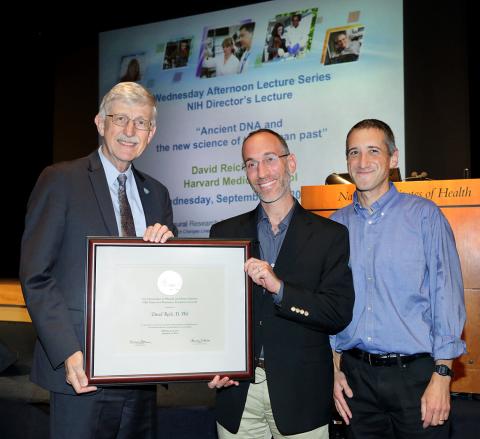Ancient DNA Is ‘New Machine’ For Peering into Human Past

Photo: Ernie Branson
“When we’ve been there 10,000 years, bright shining as the sun...,” begins a verse of Amazing Grace. According to Harvard geneticist Dr. David Reich, who opened the 2016-2017 Wednesday Afternoon Lecture Series on Sept. 21, that’s just about the time that ancient human DNA begins to loosen its tongue in order to testify to human origins and diaspora.
Reich’s lab is taking samples mostly of European human remains dating back between 4,000 and 7,000 years and, using DNA sequencing machines that have gotten faster and cheaper over time, begun to learn the recipe for making a modern European.
“I work on human bones, mostly,” said Reich, who called the ability to analyze ancient DNA “a new scientific instrument, developed in the last 5 or 6 years.”
Combined with sophisticated mathematical analysis (including such tools as “statistical reconstruction” and “principal component analysis”), the industrial-strength sequencing technology used to study about 1,000 samples a year is yielding insights into how three main groups of humans—farmers, hunter-gatherers and ancient north Eurasians—intermingled to form a borderless biological identity.
“Three highly different ancestral populations combined to yield modern Europeans,” said Reich.
Working in “clean” rooms under positive pressure, in order to avoid contamination with modern DNA from people and microbes, scientists in body suits work under fume hoods that are sterilized using ultraviolet light after use. They use low-speed drills to penetrate the surface of ancient bones and extract a powder that is then demineralized, and proteins are extracted. What remains is then sequenced with modern machines that have gotten 10,000 times more powerful in the last decade, Reich said.
In 2010, four ancient samples were sequenced, he reported. Twenty or 30 more were sequenced in 2014. “In 2015, things went into hyper-drive, and several hundred samples were sequenced,” said Reich. “We’ve sequenced more than 1,000 samples in our own lab—there’s not enough time to publish” all the data they are collecting.
Indeed, on the day of the lecture, the New York Times ran a front-page story on studies of ancient DNA that included Reich’s lab’s work (“A Single Migration From Africa Populated the World, Studies Find”).
Reich and his colleagues in this burgeoning new field are reconstructing human history a base-pair at a time and arriving at some general conclusions: West Eurasians from Europe to Iran “are genetically strikingly similar,” as are East Asians from Korea to Indonesia, and Africans from Senegal to Zimbabwe.
“They are these massive mixtures of different populations,” said Reich, who noted that genetics offers a new window onto the past to complement the traditional ones of archaeology and language.
The arrival of farming, probably from Turkey, or Syria, or Iraq, was a major driver of genetic mixture. It allowed populations to grow dense in single locales and prompted “huge movements of people,” said Reich. “There was a large-scale migration from the near East.”
He said there is evidence that Native Americans originated in part from a “ghost population” that inhabited northern Eurasia more than 15,000 years ago, and that also contributed to Europeans.

Photo: Ernie Branson
The genetic impact of this northern Eurasian population on Europe occurred around 4,500 years ago via the arrival of the Yamnaya steppe pastoralists, a group that made use of the wheel to extend the reach of herding; Reich quipped that they employed “mobile homes” to exploit the Russian steppe.
Large-scale migration led to the breakdown of social barriers, says Reich.
“Near-Eastern farming expansion and its after-effects homogenized west Eurasia,” he said.
Reich and others in his field are using genome-wide association study data collected as part of medical studies to probe not just ancient history but also the biological impact of such crucial genetic traits as the ability to digest milk into adulthood, a mutation that conferred an important survival benefit. Complex traits such as height are also amenable: why are Europeans from the Netherlands and Croatia taller, and why are people in Portugal shorter? Reich described how genetic data shows that the ancestors of Portuguese experienced natural selection to get shorter after the arrival of farmers in Europe.
Students of DNA also aim to explain how modern traits have evolved over time, beginning with the Neanderthals 200,000 years ago in East Africa, who took 150,000 years to become behaviorally like us. “People 50,000 years ago had all of the mutations needed to do all that we do today,” said Reich. But he says that the frequencies of these mutations likely changed in order to adapt to changing conditions.
He suspects that environmental and cultural changes were as significant as genetic adaptations as drivers of mankind’s current capabilities.
“It is unlikely that there will be reductionist genetic answers,” he said. “We must embrace the complexity.”
The complete talk is available at https://videocast.nih.gov/summary.asp?Live=19940&bhcp=1.
